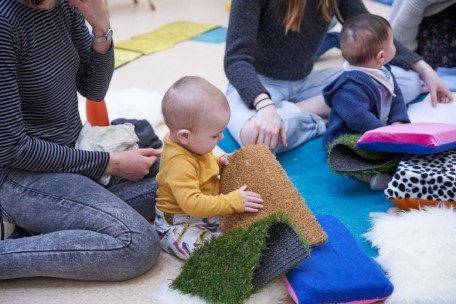This week’s object has been chosen by students on the Medieval and Renaissance Year Course, and is by the great Florentine sculptor Donatello (1386-1466). It is an image of the Virgin and Child, by far the most common type of privately owned art object in this period. Images such as this served as aids to daily prayer, and were available in a wide range of materials, styles and formats, to suit different tastes and budgets. The Virgin and Child is a tiny relief, only 12 cm high, in painted stucco – a form of plaster – set into a gilded wooden ‘tabernacle’ frame. On either side of the frame, a pair of angels hold a billowing mantle over the Virgin and Child, like a simple canopy; above, in the gable, is a figure of God the father, his hand raised in blessing, and holding the orb that signifies the world; below, the recumbent figure of Eve is a reminder of Mary’s role as the new or second Eve, whose role is to redeem the original sin committed by Eve herself. Beneath, on a console, is a figure of a prophet with a scroll foretelling the birth of Christ. The frame is decorated with an inscription bearing the words ‘Ave Maria, Gratia Plena’ [Hail Mary, full of grace], the opening of one of the most popular prayers to the Virgin, which would presumably have acted as a prompt for the owner of the image.

Donatello, Virgin and Child, Florence, Italy, Painted and gilded stucco in a contemporary wood frame, Medieval and Renaissance Galleries, Room 64, Case 4, Mus Ref: A.45-1926 © Victoria and Albert Museum, London
Stylistically, the relief stands on the cusp between ‘medieval’ and ‘renaissance’, suggesting a date in the 1430s or 40s. The Virgin resembles the type of an ancient Roman matron, in severe profile, with crimped hair and straight nose, although her white and blue striped headscarf is typical of the sort of head covering worn by non-elite women in mid-fifteenth-century Italy, perhaps to resonate with the contemporary user, who might well have been a woman. The form of the frame, with its triangular pediment, also reflects the newly fashionable classical style. The painted figures, attributed to the Florentine painter Paolo di Stefano, are in a more conservative style, most notably the semi-nude figure of Eve, which possesses none of the classicising elements found in contemporary sculpture.

Donatello, Virgin and Child Plaquette, Florence, Italy, Bronze, Mus Ref: 5473-1859 © Victoria and Albert Museum, London
The stucco relief was cast after a bronze plaquette by Donatello, which is displayed nearby. Both bronze and stucco could be produced serially, using moulds, but while bronze was comparatively costly, stucco was an inexpensive material. It could, however, be painted and gilded, and set in a frame, as here, to create the impression of a more materially sumptuous object. Inexpensive stucco reliefs could be bought ‘off the peg’ in the artist’s workshop, or customised for the client. Our Virgin and Child is testimony to the growing market for affordable domestic images amongst the middle class, as distinct from elite families such as the Medici, and the development of new, inexpensive reproductive techniques to meet demand.
One of the things that make our Virgin and Child so appealing is that we can easily imagine how it was displayed. It still preserves the iron ring, at the top of the pediment, from which it was suspended, and there are hinges on either side of the frame, suggesting that it once had wings that could be closed over the image. It would be kept closed when not in use, and opened for prayer: the practice of concealing and revealing added to the drama of devotion and contributed to the sacred aura of the image itself. Hanging on the wall, probably in a bedroom, an image of the Virgin and Child – even from behind closed doors – sanctified the room; smaller ones, such as this – its total height, including the frame, is only 36.5 cm – could also be taken down and held in the hands, or even kissed, during the most intimate moments of prayer.
Urban audiences were encouraged by preachers to measure their private lives against ideals of pious behaviour. St Antoninus, Archbishop of Florence (1389-1449), recommended mothers to show their children the image of the Virgin and Child displayed in their homes, as exemplary behavioural models, eloquent testimony to the potency images such as this possessed for ordinary people going about their daily lives.
“Twenty Objects for Twenty Years” is a series of articles written by Paula Nuttall, Director of the Late Medieval to Early Renaissance Year Course, exploring some of her favourite pieces in the V&A’s extensive Renaissance collections along with contributions from students and museum staff. You can find the rest of the series along with other posts from the Learning Department at the V&A on their blog.


